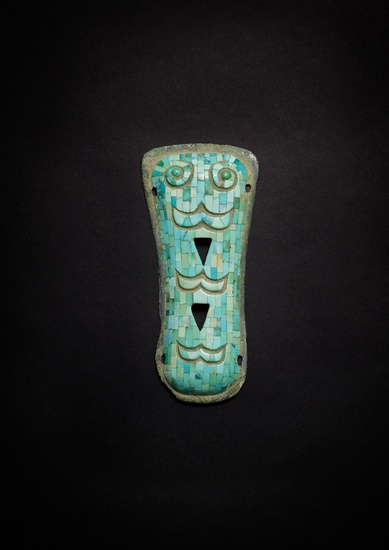A rare turquoise-inlaid bronze plaque, Early Shang dynasty, possibly Erlitou...
Property from an Important Japanese Collection
A rare turquoise-inlaid bronze plaque,
Early Shang dynasty, possibly Erlitou culture
日本顯赫收藏
商初 或二里頭文化 青銅嵌綠松石牌飾
13 cm
Condition Report:
In overall good condition, with expected age-consistent chips to the edges of the plaque as visible in illustration. Some turquoise inlay possibly reattached or replaced. X-ray available upon request.
總體品相良好,如圖所示邊沿有符合時態特征之磕碰,部分綠松石或修補或替換。X光片備索。
Catalogue Note:
Carefully set with hand-cut tesserae of turquoise in a stylised zoomorphic pattern, this piece belongs to an extremely rare group of inlaid bronze plaques. To date, only three plaques of this type have been excavated from the archaeological site at Erlitou in Henan Province, with around seven more in museum collections around the world. Found only in the most lavish tombs lying atop or alongside the deceased with other valuable ritual objects, these plaques are believed to have been possessions of elite ritual practitioners. For example, a related plaque, recently exhibited at the Shanghai Museum, was excavated in 1984 alongside extraordinary objects such as jade blades and a bronze bell with a jade clapper; another Erlitou turquoise-inlaid plaque, one of only two to have come up at auction, was exhibited at Eskenazi Ltd., Inlaid Bronze and Related Material from Pre-Tang China, London, 1991, cat. no. 68, and sold at Christie's Hong Kong, 3rd June 2015, lot 3201.
Turquoise inlaid plaques of this type vary somewhat in form and design; the present piece being slightly longer in shape and with a more abstract design than other known examples. This piece is also the only known example with triangular openwork and three mouth-like designs along its central axis. Moreover, while other known plaques have four eyelets cast along their perimeter, the present piece incorporates these holes into the main body of the plaque. What unites all of these plaques, however, is the presence of two round turquoise eyes. Likely predecessors of the taotie motif of the Shang dynasty, these imposing beady eyes would have been a fearsome sight to behold when strapped to the arm or chest of the practitioner. Though the specific meaning of this stylised beast has long since been lost to history, pieces of this kind clearly played an important role in the traditions of this ancient civilisation.
Provenance:
Kaikodo, New York, 21st September 1996.
懷古堂,紐約,1996年9月21日
View it on
Estimate
Time, Location
Auction House
Property from an Important Japanese Collection
A rare turquoise-inlaid bronze plaque,
Early Shang dynasty, possibly Erlitou culture
日本顯赫收藏
商初 或二里頭文化 青銅嵌綠松石牌飾
13 cm
Condition Report:
In overall good condition, with expected age-consistent chips to the edges of the plaque as visible in illustration. Some turquoise inlay possibly reattached or replaced. X-ray available upon request.
總體品相良好,如圖所示邊沿有符合時態特征之磕碰,部分綠松石或修補或替換。X光片備索。
Catalogue Note:
Carefully set with hand-cut tesserae of turquoise in a stylised zoomorphic pattern, this piece belongs to an extremely rare group of inlaid bronze plaques. To date, only three plaques of this type have been excavated from the archaeological site at Erlitou in Henan Province, with around seven more in museum collections around the world. Found only in the most lavish tombs lying atop or alongside the deceased with other valuable ritual objects, these plaques are believed to have been possessions of elite ritual practitioners. For example, a related plaque, recently exhibited at the Shanghai Museum, was excavated in 1984 alongside extraordinary objects such as jade blades and a bronze bell with a jade clapper; another Erlitou turquoise-inlaid plaque, one of only two to have come up at auction, was exhibited at Eskenazi Ltd., Inlaid Bronze and Related Material from Pre-Tang China, London, 1991, cat. no. 68, and sold at Christie's Hong Kong, 3rd June 2015, lot 3201.
Turquoise inlaid plaques of this type vary somewhat in form and design; the present piece being slightly longer in shape and with a more abstract design than other known examples. This piece is also the only known example with triangular openwork and three mouth-like designs along its central axis. Moreover, while other known plaques have four eyelets cast along their perimeter, the present piece incorporates these holes into the main body of the plaque. What unites all of these plaques, however, is the presence of two round turquoise eyes. Likely predecessors of the taotie motif of the Shang dynasty, these imposing beady eyes would have been a fearsome sight to behold when strapped to the arm or chest of the practitioner. Though the specific meaning of this stylised beast has long since been lost to history, pieces of this kind clearly played an important role in the traditions of this ancient civilisation.
Provenance:
Kaikodo, New York, 21st September 1996.
懷古堂,紐約,1996年9月21日



